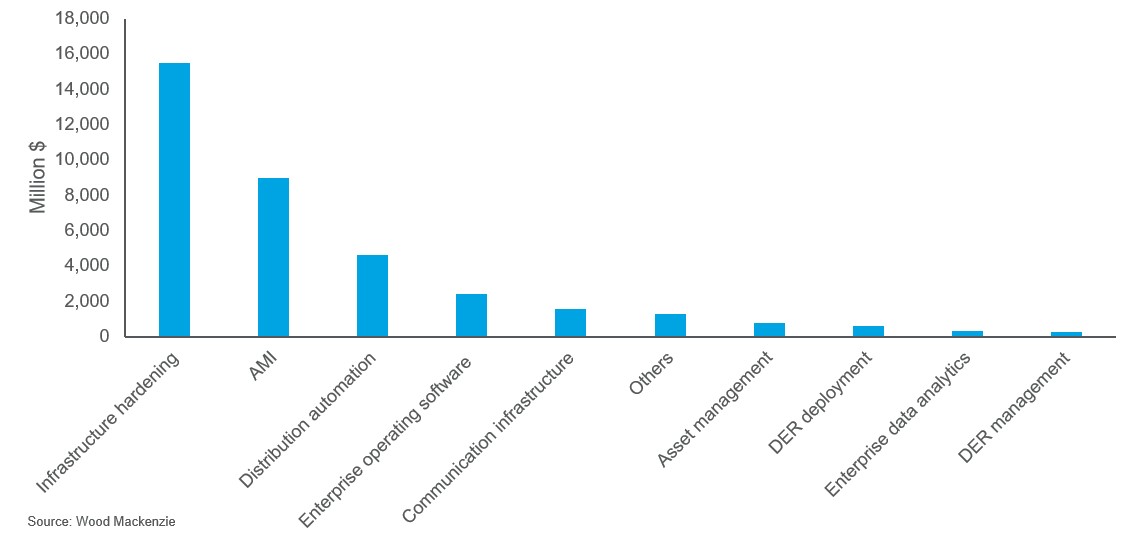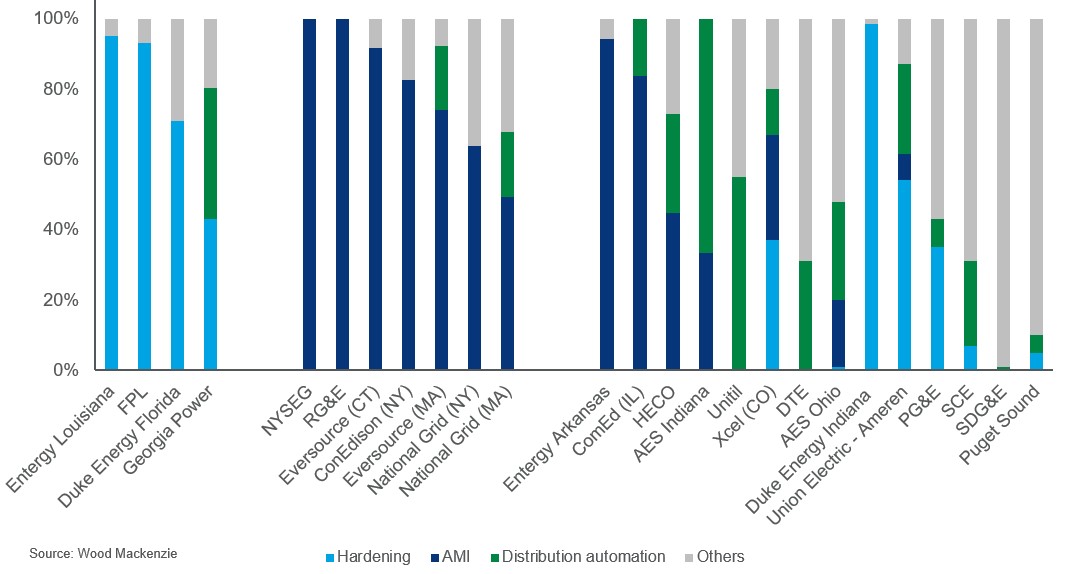Get in touch
-
Mark Thomtonmark.thomton@woodmac.com
+1 630 881 6885 -
Hla Myat Monhla.myatmon@woodmac.com
+65 8533 8860 -
Chris Bobachris.boba@woodmac.com
+44 7408 841129 -
Angélica Juárezangelica.juarez@woodmac.com
+5256 4171 1980 -
BIG PartnershipWoodMac@BigPartnership.co.uk
UK-based PR agency
US$36.4B of grid modernization planned by investor-owned utilities
Grid modernization investment sees 37% CAGR since 2012; largest emphasis on achieving higher efficiencies in the operation of the grid and protecting physical infrastructure from catastrophic weather
2 minute read
In efforts to modernize distribution grids, 25 investor-owned utilities (IOU) have filed for $36.4 billion of investment. These investments have been carried over into or filed after 2018, through general rate cases, grid modernization (GM) plans, and targeted applications based on specific needs, according to a new analysis from Wood Mackenzie.
The report notes that GM investment has grown with a 37 percent compound annual growth rate since 2012. The rate of growth is accelerating in recent years, with a 71 percent jump in investment from 2022 to 2023. This acceleration will lead to 2024 seeing the highest level of annual investment by the studied IOUs, estimated at $5.9 billion.
While most GM initiatives are driven by DER integration and achieving higher grid operation efficiencies, recent catastrophic weather events have redirected GM expenditure back to infrastructure hardening, according to Wood Mackenzie’s “Utility investment in grid modernization H1 2023” report.
“We have seen GM investment grow exponentially in the last several years, with base rate the main cost recovery mechanism,” said Fahimeh Kazempour, head of Grid Modernization for Wood Mackenzie. “However, these days regulators are showing more openness for utilities to use alternative cost-recovery mechanisms for their grid modernization investments such as riders and cost reconciliation to limit disallowance risk and regulatory lags inherent in the rate base.”
Infrastructure hardening and AMI account for the largest expenditures
Infrastructure hardening to protect against catastrophic weather, advanced metering infrastructure (AMI) and distributed automation represent 80% of current GM investment. Investment in distributed energy resources (DER) deployment and management is only at 2.4%, but, as most requests have been filed after 2021, they have the potential to surface as emerging GM solutions.
“Utilities are quoting DER integration and market enablement as the primary driver for their GM investments. When we compare DER-driven GM investments with the level of investment in DER management solutions, however, our data suggest that utilities are designing the grid to withstand the scale and variability of DERs rather than integrating more closely with them," said Kazempour.
DERs are the primary driver for advanced distribution management system (ADMS) expenditure, at almost $1 billion, which subsequently is creating a boost for GIS investment as ADMS’s enabling technology.

Regions differ on investment needs
Planned utility GM investments vary based on state and geographic needs. The southeast has focused mainly on infrastructure hardening, as the region often deals with catastrophic weather events, such as hurricanes. The northeast has demonstrated elevated levels of investment in AMI, positioning it to implement advanced rates and shape prosumer behavior.

States policies and regulatory environment play critical roles in GM investment strategy
“These investments depend a lot on each state’s policy or regulatory environment,” said Kazempour. “Some regulators require utilities to submit long-term GM strategy and investment plans to support their states’ specific decarbonization targets. An increasing number of regulators are allowing utilities to address their GM needs outside their rate cases. And when reliability and resilience concerns justify it, some regulators support controversial investments in capital-heavy infrastructure and utility ownership of DERs. What strategy a utility will take often depends on where they are located.”





